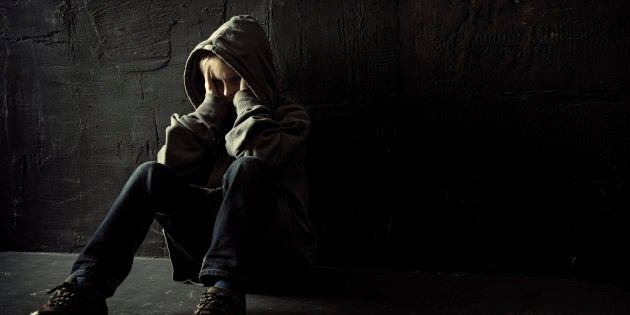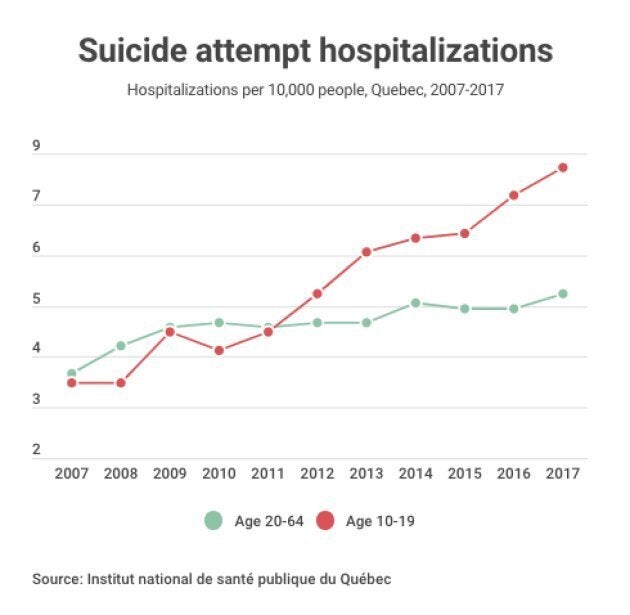
MONTREAL — Mental health issues have been making headlines, and new data from Quebec's health-care system has revealed an increase in youth hospitalizations related to suicide.
According to statistics compiled for HuffPost Quebec by the National Institute of Public Health of Quebec (INSPQ), the rate at which children and teens ages 10 - 19 are hospitalized after a suicide attempt doubled in the province over a decade.
There were 8.2 hospitalizations per 10,000 people in 2017, up from 3.6 hospitalizations per 10,000 people in 2007.
This is worrying data, said Pascale Lévesque, the scientific advisor at INSPQ who compiled the statistics.
But she cautions that, as this is the first time this data has been collected, she does not want to risk concluding that it means there is an increase in suicide attempts among young people in general.

The INSPQ data doesn't indicate how many people overall came to the emergency room after a suicide attempt, but only how many of them were hospitalized.
This means these numbers could indicate a larger issue — but it could also mean that staff are hospitalizing youth after suicide attempts more frequently than they used to.
In any case, "We can't leave it at this, we have to take an interest, that's for sure ... we need to go further," Lévesque said.
Watch: Fostering mental health — tips for parents. Story continues below.
Brett Burstein, a pediatric emergency room doctor at Montreal Children's Hospital, described the problem as "huge and disturbing."
Burstein, a research clinician at the McGill University Health Center Research Institute, released a study using U.S. data on the subject in the journal JAMA Pediatrics last week.
It found the number of children and adolescents traveling to emergency rooms for suicide attempts or suicidal thoughts doubled between 2007 and 2015, reaching 1.1 million hospital visits.
Burstein suspects the trend is the same on this side of the border, because that's what he notices at the hospital: the number of emergency room visits for suicidal thoughts or attempts has increased by 55 per cent in the past three years.
Earlier on HuffPost Canada:
A possible explanation of these figures is that suicidal ideation is perhaps being better tracked today. Burstein is skeptical of this theory, since according to the data he collected in the U.S., 88 per cent of emergency department visits were for suicidal acts, not suicidal thoughts.
For him, this trend requires policymakers to take a greater interest in suicide prevention, and develop better tools to identify at-risk individuals.
The Quebec youth crisis hotline, Tel-Jeunes, reports a significant increase in interventions, particularly since the group launched a chat service in 2011 and texting service in 2013.
Suicidal thoughts are often a common theme, said Tel-Jeunes employee Élise Huot. "We have really high volume, and we've noticed it."
More people aged 10 to 13 are contacting the hotline, she said.
Huot figures the phenomenon "probably always existed," but there are more tools today than ever before with which to reach at-risk individuals.
Younger children are affected
In his U.S. study, Burstein noted that 43 per cent of all young patients who visited the ER for suicidal thoughts or actions were between 5 and 11 years old.
"It's something new enough: we tend to think of it as a problem that traditionally affected teenagers," he said.
The data provided by the INSPQ on the rate of hospitalization after a suicide attempt do not include children under 10, since, according to Lévesque, these data were too variable, and therefore not "robust enough" for data collection.
Burstein said that every day, one or two children aged 12 and under go to the Montreal Children's Hospital, where he works, for suicidal thoughts or actions.
Risk factors are complicated
Suicide is complex, and it's difficult to pinpoint the reasons behind these figures. For the moment, we can only speculate, said Christine Grou, president of the Order of Psychologists of Quebec.
Grou believes that reaching out for help is becoming more common, as despair and a lack of support take their toll.
Young people are under pressure to perform today. "You have to be attractive, positive, efficient, good at sports ..." Grou said.
Yes, there are social networks, of course, that always show us images of perfection. But there is also an obsession to be good at everything.
"Look at the number of activities in which a young person is registered, look at their schedule," the psychologist said. "Moreover, there is growing anxiety among young people. Some feel that they can not 'do it.' Either they do not have the tools, or the pressure is too much."
'Any attempt or comment about suicide should not be trivialized'
The suicide rate has been relatively stable over the past 10 years, for both youth and older people. Burstein believes that young people use methods of self-harm that are less likely to be fatal.
"Desire, often, is not a desire for death: it's a call for help, a need for respite," said Grou.
But that doesn't mean we shouldn't take the call for help seriously, said the director general of the Quebec Association for Suicide Prevention, Jerome Gaudreault.
"Any attempt, and even any comment about suicide, should not be trivialized," he said. "We are not talking about suicide to manipulate people, but because we are experiencing real distress. And be aware that a first suicide attempt is a very important risk factor to make another, later, completed attempt."
The key to prevention is better accessibility to care that is adapted to young people, Grou believes. It could be, for example, the presence of a psychologist at school, whom students can access informally, without the parents being involved.
Grou also believes that there should be better training for young people and teaching staff to better recognize psychological distress and above all, to make discussing it less taboo.
"We could also have peer helpers in schools, young adults who have also gone through more difficult times and are there to help," she said.
That's because the most important thing is to prevent the crisis in the first place, Grou said.
Are you in a crisis? If you need help, contact Crisis Services Canada at their website or by calling 1-833-456-4566. If you know someone who may be having thoughts of suicide, visit CAMH's resource to learn how to talk about suicide with the person you're worried about.
Translation by Daniel Tencer.
Also on HuffPost: